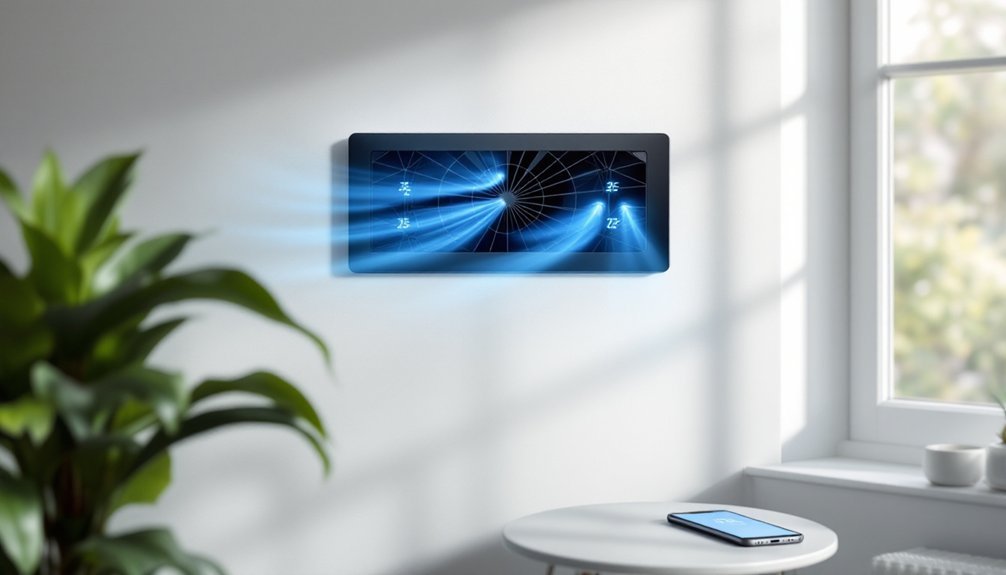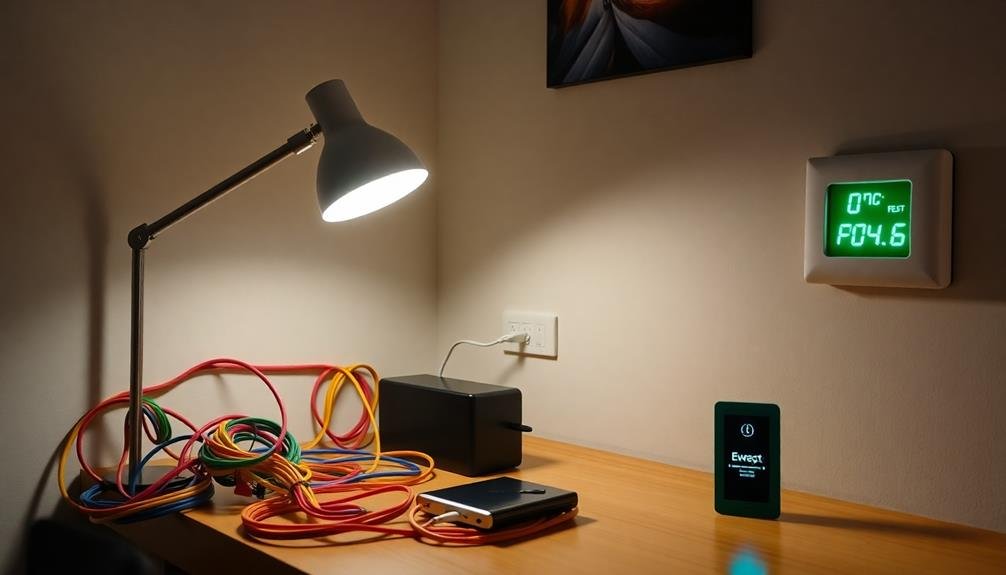You're about to discover how the latest smart vent technology can transform your home's climate control experience. From whisper-quiet operation to precision temperature management, these seven innovative solutions offer more than just basic airflow adjustment. They'll help you tackle those frustrating hot and cold spots while potentially reducing your energy bills. Let's explore how these advanced systems can make your home more comfortable and efficient in 2025.
10 Inch Shutter Exhaust Fan with Temperature Humidity Controller
With an impressive 576 CFM airflow capacity, the 10-inch AITECAC Airbird T10 shutter exhaust fan is ideal for homeowners seeking versatile ventilation solutions. You'll appreciate its rugged all-metal design featuring powder-coated steel and aluminum alloy components that resist rust and weather damage.
The digital controller lets you adjust between five speeds and set temperatures from 32-122°F. You'll find the automatic blinds particularly useful, as they seal tightly when the fan's not in use. Whether you're ventilating your attic, greenhouse, garage, or workshop, this 35-watt unit installs easily with its plug-and-play setup and 11.5-foot power cord. At 1600 RPM, it operates quietly while effectively moving air.
Best For: Homeowners and DIY enthusiasts looking for a versatile, high-capacity exhaust fan for spaces like attics, greenhouses, garages, or workshops where temperature and humidity control are important.
Pros:
- Powerful 576 CFM airflow with 5 adjustable speeds and digital temperature control
- Durable all-metal construction with weather-resistant coating and automatic sealing blinds
- Easy plug-and-play installation with included 11.5-foot power cord
Cons:
- Relatively high price point compared to basic exhaust fans
- May be oversized for smaller spaces or basic ventilation needs
- Limited number of customer reviews to verify long-term reliability
AirBlaze Z4 Smart Register Booster Fan with Thermostat Control
Smart-home enthusiasts seeking precise temperature control will find their match in the AirBlaze Z4 Smart Register Booster Fan. This sleek unit, designed for 4"x10" register holes, offers 10-speed settings and operates quietly at under 18 dBA. You'll appreciate its high-precision temperature sensors that automatically adjust fan operation based on your preferred settings.
The Z4's dual ball bearing motor boasts a 67,000-hour lifespan, while its remote control works within a 5-meter range. You can install it on walls or floors to optimize airflow distribution. Though the power cord visibility might concern some users, the unit's performance in balancing room temperatures and its 4.2-star rating from over 600 customers make it a solid choice.
Best For: Homeowners looking to improve HVAC efficiency in specific rooms and tech-savvy users who want precise temperature control with remote operation capabilities.
Pros:
- Advanced temperature sensing and 10-speed control options provide excellent customization for comfort
- Long-lasting dual ball bearing motor with 67,000-hour lifespan ensures durability
- Quiet operation under 18 dBA makes it suitable for bedrooms and quiet spaces
Cons:
- Visible power cord may affect aesthetic appeal in some installations
- Some users report difficulty finding optimal temperature activation settings
- Higher fan speeds can produce noticeable noise despite overall quiet operation
AC Infinity AIRTAP T4 Bronze Register Booster Fan
The AC Infinity AIRTAP T4 Bronze Register Booster Fan stands out as an ideal solution for anyone struggling with uneven heating or cooling in their home. You'll find this smart register booster packs impressive features, including a 10-speed controller, Bluetooth connectivity, and automated temperature triggers.
With its dual 92mm engine delivering 130 CFM airflow at just 17 dBa, you're getting powerful performance without disruptive noise. The digital display shows duct temperature, helping you set precise heating and cooling triggers. Installation's a breeze, and you can easily route the power cord outside the 4" x 10" register. While it's pricier than basic boosters, users consistently report significant temperature improvements in previously uncomfortable rooms.
Best For: Homeowners looking to improve heating and cooling in specific rooms with poor airflow, particularly spaces far from the HVAC unit or those experiencing temperature inconsistencies.
Pros:
- Advanced smart features including app control, programmable settings, and automated temperature triggers
- Powerful yet quiet operation with 130 CFM airflow and low 17 dBa noise level
- Easy installation process with straightforward wiring and comprehensive temperature monitoring
Cons:
- Higher price point compared to basic register boosters
- Can produce noticeable noise at higher speed settings
- Digital display shows duct temperature rather than room temperature, which may confuse some users
Quiet Register Booster Fan with Remote & Thermostat Control
Temperature warriors seeking precise climate control will find their match in this whisper-quiet register booster fan. Operating at just 18 Dba with 120 CFM airflow, it's perfect for bedrooms and living spaces where silence matters.
You'll love the smart features – a 10-speed remote control lets you adjust settings from anywhere, while the thermostat automatically maintains your desired temperature. The unit keeps running even after your HVAC shuts off, maximizing efficiency in those traditionally hard-to-regulate rooms.
Installation's a breeze with plug-and-play setup, and at only 6W power consumption, you'll see the difference in both comfort and energy bills.
Best For: Homeowners looking to balance temperatures in specific rooms that are consistently too hot or cold compared to the rest of their house, especially those with multi-story homes or rooms far from the main HVAC unit.
Pros:
- Exceptionally quiet operation at 18 Dba makes it ideal for bedrooms and living spaces
- Smart thermostat control with 10-speed settings and remote operation offers convenient temperature management
- Easy plug-and-play installation requires no special tools or expertise
Cons:
- Limited to 4 x 10 register holes, may not fit all vent sizes
- Requires nearby electrical outlet for power adapter
- May not completely solve temperature issues in extremely problematic rooms or poorly insulated spaces
VIVOSUN Quiet Register Booster Fan with Thermostat Control
Noise-conscious homeowners will appreciate VIVOSUN's ultra-quiet register booster fan, which operates at just 18 dB while intelligently managing room temperatures. The unit fits standard 4×10 registers and features a programmable LCD controller with 10 fan speeds and temperature sensing.
You'll get peak performance when mounting this Energy Star compliant device on wall or floor registers, but avoid ceiling installations. Its hydro-mechanical stator blades and PWM-controlled motor deliver efficient airflow distribution, though you might notice some resistance when the fan's off.
While it's effective for both heating and cooling, you'll get best results at lower speeds, as maximum settings can increase noise levels. For larger spaces, consider installing multiple units.
Best For: Homeowners looking to balance room temperatures and improve HVAC efficiency while maintaining a quiet environment, particularly in bedrooms and home offices.
Pros:
- Ultra-quiet operation at 18 dB with energy-efficient performance
- Smart thermostat control with 10 adjustable fan speeds and LCD display
- Easy installation on standard 4×10 floor or wall registers
Cons:
- Becomes noticeably louder at maximum speed settings
- Creates some airflow restriction when fan is turned off
- May require multiple units for larger spaces to achieve desired temperature balance
Smart Register Booster Fan with Thermostat Control (4" x 10")
Perfect for homeowners struggling with uneven heating and cooling, this smart register booster fan combines intelligent temperature sensing with adjustable airflow control. You'll appreciate its compact 4" x 10" design and energy-efficient operation, consuming just 6W while delivering up to 120 CFM of airflow.
The unit's LCD display lets you monitor room temperature and adjust fan speeds from 0-10, though you'll want to keep it below level 5 to avoid noise issues. While installation is straightforward with the included wall adapter, be aware that programming can be tricky. Despite mixed reliability reviews, you'll see up to 40% energy savings when used properly.
Best For: Homeowners with multi-level homes or rooms with temperature inconsistencies who want to improve HVAC efficiency without major system modifications.
Pros:
- Energy efficient operation with only 6W power consumption while providing up to 120 CFM airflow
- Adjustable fan speeds and temperature sensing allow customizable comfort control
- Easy plug-and-play installation with included wall adapter
Cons:
- Can be noisy at higher fan speeds (above level 5)
- Programming interface can be complex and challenging to set up
- Mixed reliability reviews with some units failing after several months of use
Quiet Register Booster Fan with Smart Thermostat Control (4×10 Vertical)
Homeowners seeking enhanced room comfort will find the Quiet Register Booster Fan's smart thermostat control a game-changing solution. The 10-speed system delivers up to 120 CFM airflow while maintaining whisper-quiet operation at just 18 dBA.
You'll appreciate the hassle-free installation and intuitive remote control. The fan's high-sensitivity temperature sensor and smart chip automatically adjust to optimize your room's climate, while the PWM motor ensures efficient performance year-round. If you've got a small room, one unit will suffice, but larger spaces may require multiple fans.
Don't forget to measure your register's hole cutout (4×10) before purchasing to guarantee a perfect fit.
Best For: Homeowners looking to improve HVAC airflow and temperature control in poorly ventilated rooms, especially those with uneven heating or cooling distribution.
Pros:
- Extremely quiet operation with adjustable 10-speed settings and low 18 dBA noise level
- Smart thermostat control with automatic temperature sensing for efficient operation
- Easy DIY installation with included wall adapter and 12-foot power cord
Cons:
- Requires electrical outlet access near the register for operation
- Multiple units may be needed for larger rooms, increasing overall cost
- Limited effectiveness when AC is actively running compared to post-AC operation
Factors to Consider When Choosing Smart Vents for Room-by-Room Temperature Control
When you're ready to upgrade your home with smart vents, you'll need to evaluate several key factors including the physical installation space, decibel ratings, and precise temperature management features that match your needs. Your selection should factor in the vent's energy efficiency scores and whether it integrates with your existing HVAC system to maximize cost savings. Smart vents with robust remote operation capabilities through mobile apps or voice assistants can give you convenient control from anywhere, making room-by-room temperature adjustments effortless.
Installation Requirements and Space
Installing smart vents successfully requires careful attention to space and sizing requirements before making your purchase. You'll need to match your existing register holes with standard dimensions, such as 4" x 10", to guarantee proper fit and functionality.
Most smart vents feature plug-and-play designs that you can install without professional help. Before mounting, verify that there's sufficient clearance behind the vent for proper airflow circulation. You don't want restrictions that could compromise the system's efficiency.
Consider cord management during installation to maintain a clean appearance. Many modern smart vents offer solutions to hide power cables, preventing unsightly wires from disrupting your room's aesthetics. Follow the manufacturer's instructions carefully, as they'll guide you through the straightforward setup process and help you avoid common installation pitfalls.
Noise Level Considerations
Noise levels can make or break your smart vent experience, especially in sound-sensitive areas like bedrooms and home offices. Most quality smart vents operate quietly at around 18 dBA, which won't disturb your daily activities or sleep.
When selecting your smart vent, pay attention to the fan speed settings and motor type. PWM motors typically offer the best balance between efficient operation and noise control. You'll want to avoid running vents at higher speeds (above level 5) in quiet spaces, as they can become disruptive.
Look for models with adjustable fan speeds so you can customize the balance between airflow and noise. Before making your final choice, consider your room's specific requirements and noise sensitivity. This flexibility guarantees you'll get peak climate control without sacrificing acoustic comfort.
Temperature Control Features
Temperature control features represent the heart of any smart vent system, enabling precise room-by-room climate management through advanced sensor technology. You'll find that modern smart vents come equipped with high-precision temperature sensors that automatically adjust airflow based on your preferred settings.
When selecting a smart vent, look for customizable temperature triggers that let you set specific thresholds for fan operation. You'll want to take into account models that offer multiple speed settings, allowing you to balance effective temperature control with noise levels. The best systems include programmable timers and cycle settings that optimize energy usage by running only when necessary. Real-time temperature monitoring through digital displays is another essential feature, helping you make informed decisions about your HVAC settings and ensuring each room maintains your desired comfort level.
Energy Efficiency Ratings
Energy efficiency ratings serve as a crucial benchmark when evaluating smart vent options for your home. You'll want to look for models that carry the Energy Star certification, as these products demonstrate superior efficiency and can lead to substantial savings on your utility bills. Smart vents can help you achieve up to 40% energy savings by optimizing your HVAC system's performance.
When reviewing efficiency ratings, don't overlook the unit's noise level (measured in dBA), as quieter operations typically indicate more effective energy use. Additionally, consider the motor's lifespan, with premium models offering up to 67,000 hours of operation. A longer-lasting motor not only reduces replacement costs but also guarantees consistent energy efficiency throughout the product's life cycle, maximizing your long-term savings and environmental impact.
Remote Operation Capabilities
When choosing a smart vent system, remote operation capabilities stand out as a game-changing feature for precise climate control. You'll find most modern smart vents offer control distances of up to 5 meters through included remote controls, letting you adjust settings without leaving your comfortable spot.
Today's advanced models go beyond basic remote functionality by incorporating temperature sensors that automatically adjust based on your preset preferences. You can monitor and modify your home's climate from anywhere using smartphone apps or voice commands, thanks to wireless integration with smart home systems. This technology doesn't just add convenience – it's a powerful tool for improving your home's energy efficiency. By enabling real-time adjustments based on temperature readings, you'll maintain ideal comfort while reducing unnecessary heating and cooling.
Airflow Capacity Needs
Understanding airflow capacity stands as a critical first step in selecting the right smart vents for your home. You'll need to match your smart vent's CFM (cubic feet per minute) rating with your HVAC system's output to prevent pressure issues and guarantee peak performance.
For your smaller rooms, you can opt for vents with lower CFM ratings, while larger spaces demand higher airflow capacity. When evaluating your needs, consider key room factors like size, insulation quality, and the number of windows and doors. These elements directly impact how much airflow you'll need for effective temperature control.
Frequently Asked Questions
How Long Do Smart Vent Batteries Typically Last Before Needing Replacement?
You'll typically need to replace your smart vent batteries every 1-2 years, but battery life varies by brand and usage. If you're using rechargeable batteries, you'll get around 6-8 months between charges.
Can Smart Vents Be Installed in Homes With Radiant Floor Heating Systems?
You can't use smart vents with radiant floor heating since they're designed for forced-air HVAC systems. Your radiant heating doesn't use air ducts, making smart vents incompatible with your setup.
Do Smart Vents Work Effectively With Multi-Zone HVAC Systems?
Yes, you'll find smart vents work well with multi-zone HVAC systems. They can enhance your existing zones by providing finer room-level control, though you'll want to ascertain they're compatible with your specific system configuration.
Will Closing Multiple Smart Vents Damage My HVAC System?
Yes, closing too many smart vents can damage your HVAC system by increasing air pressure and straining your blower motor. You shouldn't close more than 30% of your vents to maintain safe system operation.
Are Smart Vents Compatible With All Types of Home Automation Systems?
Most smart vents work with popular platforms like HomeKit, Alexa, and Google Home, but you'll need to check specific compatibility for your system. Some vents only work with their own proprietary apps.





Leave a Reply